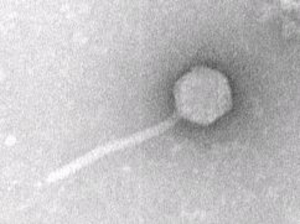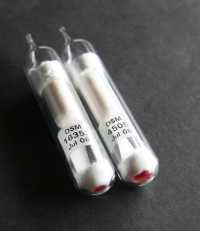Collection of Phages at the DSMZ

To find and order a specific phage of interest, please visit our catalogue first und select Bacteriophage on the left site bar.
- Supply, storage and propagation of phages
- How phages are lysing bacteria, a video
- FAQ - phages supplied by the DSMZ
The DSMZ continuously expands the phage collection. Please, send your requests to
Phages are offered by the DSMZ as 1mL liquid suspensions or as vacuum-dried suspensions on filter paper in double-vial glass ampoules. However, the delivery form depends on the phage. If both delivery forms are offered, the requestor can mention the favourable delivery form for the same fee. The DSMZ will finally decide about the delivery form.
The DSMZ will continuously expand the phage holdings. For some phages, there are only minimal data available. But, due to the high potential relevance of phages, the DSMZ also accessions phages with a minimal data background including unpublished ones. All DSMZ phages are purified over several propagation steps and routinely tested for viability. We do not provide exact titer information upon phage despatch. Please, visit our phage FAQ website.
Revitalisation of Vacuum-Dried Bacteriophages

Several phages of our DSMZ collection are delivered as lyophilised suspensions on filter paper strips or alternatively, on two identical filter discs. Our phage suspensions are titer-controlled before lyophilisation, only suspensions with documented high titer (larger than 1 x 108 pfu/mL) are used for this purpose and phage viability is controlled for each batch after lyophilisation. We do not provide exact titers after phage vacuum-drying.
Viability is documented in our archives and guaranteed for each batch. However, phage titers may vary in a range from batch to batch for each phage.
For revitalisation of vacuum-dried phages, please perform the following steps:
- Prepare a fresh (!) agar plate with the recommended host strain agar medium and plate the host using the “top agar layer method”: 3 mL of sterile soft agar (0.5% in many cases optimal) in a screw-cap vial is liquefied by heating and cooled down to 48°C and then mixed with 0.1 mL of a freshly grown host culture. This top layer mixture is immediately poured onto the bottom agar. Use only the recommended media (liquid and solid) and buffers. After a 5-10 minutes solidification of the top agar, the host plate is ready for incubation with the phage. Pre-incubation of the host plate without the phage is not necessary: host and phage will be incubated together (see below).
- Open the ampoule of the phage acc. to the procedure as described for our bacterial cultures. At this point, we strongly recommend to observe point 7.! With sterile forceps, take out the filter paper or filter disc containing the dried phage material, place it in the middle of the host plate.
- Add 0.1 mL of appropriate buffer or medium on the surface of the filter paper, incubate this plate with phage and host under conditions as described for the host, usually overnight.
- Lysis leads to a more or less clear zone around the filter paper strip or disc. Several phages cause turbid plaques and therefore also a turbid zone around the filter paper. There is no standard size or intensity of the lysis zone! For preparing a phage stock solution from such a plate with a lysis zone, phages are resolved after lysis occurred: add 2-3 mL of recommended buffer or medium to get a phage stock suspension: leave the plate at room temperature while slowly rotating on a shaker for 2-4 hrs. Then, harvest the phage suspension and pellet the bacteria by centrifugation. Filtrate the supernatant (usually 0.2 µm porous size filter) to remove remaining bacteria.
- Alternatively to lysis on agar (see above), lysis in liquid culture may be performed: add the filter paper or filter disc directly to a small exponentially growing fresh host culture (2 mL), followed by further incubating phage and host together: in a first step, leave this culture for 15-30 minutes without shaking so that phages can adsorb to bacterial cells, then further incubate the culture by shaking, as required for the respective host. Observe this culture until lysis occurs as phage-resistant bacterial mutants may arise and grow in the culture so that the lysis effect is not visible anymore. Therefore, carefully observe the lysis process and stop it when lysis is completed, harvest the phage suspension by centrifugation and filtration. Don’t incubate overnight without observing the lysis process.
- The phage suspension harvested after step 4 or 5 respectively, is the starting suspension for further purification or phage propagation steps.
- For keeping and saving phage material and propagating the phages on agar plates and in liquid culture, cut the filter paper in two pieces or use one of the two filter discs and proceed with the above steps 2 and 5 in parallel.
- Suspensions of most phages store well at 4°C for one or two weeks or longer. DSMZ does not guarantee long-term survival of phages while stored in the customer’s laboratory. All biological material delivered by DSMZ is for immediate use. Please, see DSMZ’s Terms and Conditions and our Phage FAQ.
Phage-specific information is given in the respective catalogue information. Please, carefully read all specific information before working with our phages, this includes also information on the host strain and its growth conditions.

